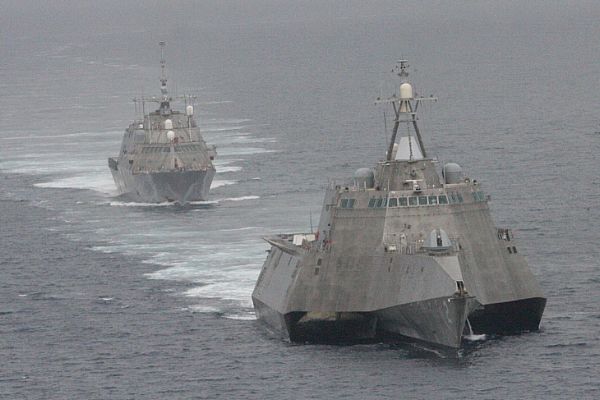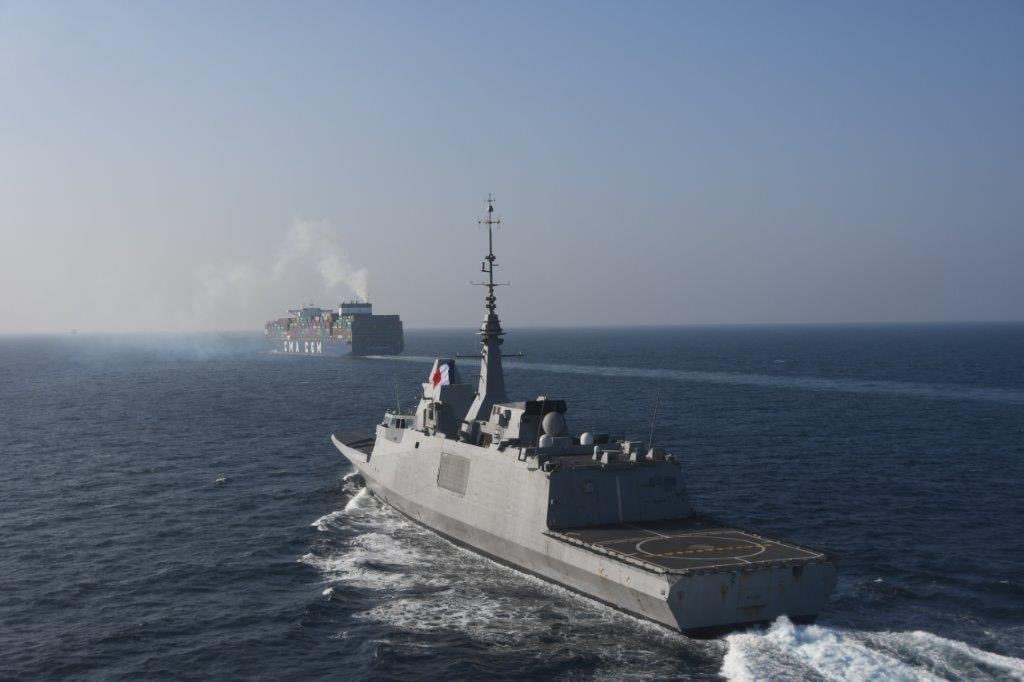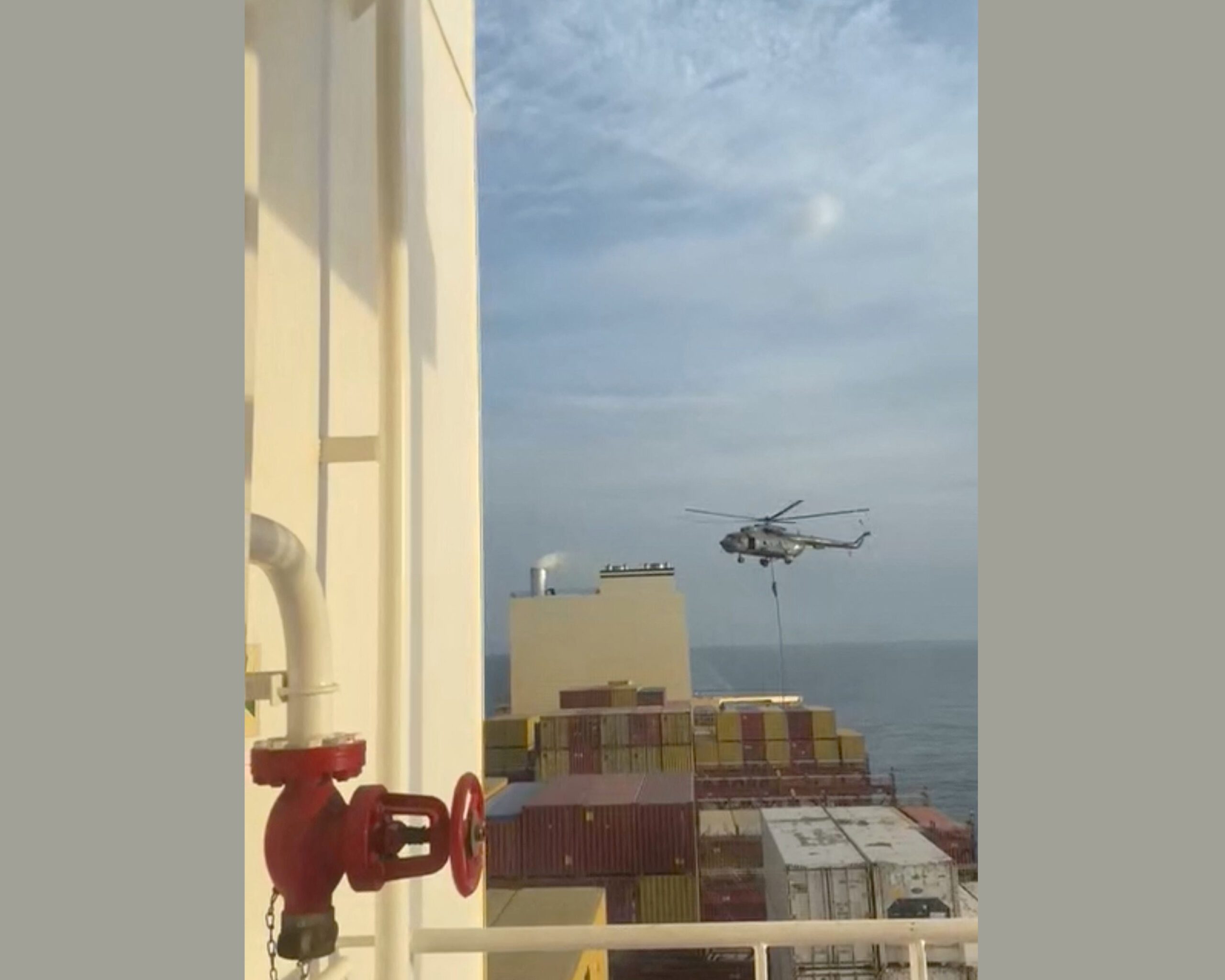The first of class littoral combat ships USS Freedom (LCS 1), rear, and USS Independence (LCS 2) maneuver together during an exercise off the coast of Southern California. Photo: U.S. Navy
David Lerman and Nick Taborek
(Bloomberg) — Navy Secretary Ray Mabus confronted a tough choice in the competition to develop a small, speedy and adaptable ship to patrol close to shore in politically turbulent waters from the Persian Gulf to the South China Sea.
When opposing bids from teams led by Lockheed Martin Corp. and Austal Ltd. came in for less than the Pentagon projected, Mabus made a costly and unusual decision: Build both versions of the Littoral Combat Ship — a conventional steel-hulled vessel and a sharp-angled aluminum alternative that has been compared to a “Star Trek” spaceship.
The 2010 decision guaranteed jobs in shipyards building the two designs and ensured political support from the communities and defense contractors that benefit. It also has added at least $400 million in taxpayer costs to support and maintain dual sets of ships over their lifespan, according to the Navy’s estimate.
As the Pentagon faces $500 billion in spending cuts over a decade that are set to begin March 1, the $37 billion program to design and build Littoral Combat Ships may become a target for reductions that would take business from Lockheed and Austal.
“The ships are costing too much,” Norman Polmar, a naval analyst and author, said in an interview. “The support costs are ridiculous with two different designs.”
The Littoral Combat Ship — derided by critics inside the Navy as the “Little Crappy Ship” — reflects the enduring influence of the “military-industrial complex” that President Dwight D. Eisenhower warned against in his 1961 farewell address. It is an example of a troubled project that has sailed on with the support of a military seeking the most advanced war- fighting equipment possible, companies eager to build it and politicians hungry for the jobs created.
Lockheed, Austal
“Pruning the LCS program severely probably would be a likely first step” if the Pentagon cuts take full effect, and that would be a setback for both prime contractors, said Stuart Slade, a naval analyst for Forecast International Inc. of Newtown, Connecticut.
“For Lockheed, it would be a blow, but one they could accommodate” as the world’s largest defense contractor, Slade said in an interview. For Austal, based in Australia, “their eyes would be seriously watering. They would be losing a very substantial portion of their U.S. naval workload.”
The estimated price to build each Littoral Combat Ship has doubled to $440 million. Cracks and corrosion plagued the first completed vessels. The Pentagon’s chief weapons tester has cited flaws with the ship’s guns, said its helicopter isn’t powerful enough to tow mine-hunting equipment and questioned whether it could carry on its mission after being hit in combat.
‘Attractive Target’
Even the number of Littoral Combat Ships the Navy needs was cast into doubt last month, when a report to Congress by the service lowered the fleet requirement to 52 vessels from 55, citing a reduced requirement for a naval presence around Africa.
“You look at the LCS and all the problems it’s had and what appears to be a limited upside — that certainly looks like an attractive target for cuts” in a time of pressure to reduce Pentagon spending, said Ben Freeman, a national security investigator at the Project on Government Oversight, a watchdog group in Washington.
Proposed after the Sept. 11, 2001, terrorist attacks, the Littoral Combat Ship is intended to replace vessels such as aging frigates in littoral waters, meaning shallow seas close to shore. It is supposed to perform missions such as destroying mines, hunting submarines, interdicting drugs and providing humanitarian relief. The idea is to outfit the ships with easily swapped equipment suited to the task at hand.
“This is the future of the U.S. Navy surface fleet,” said Christopher Preble, a defense analyst at the Cato Institute in Washington.
“We need to get this right or it could be pretty ugly.”
‘Green Water’
As the USS Freedom, the first Littoral Combat Ship to go on extended deployment, prepares to leave San Diego for Singapore next month, the Navy defends the vessel as an essential element of its future fleet.
“It’s going to do the mission that small combatants have always done,” Navy Undersecretary Robert Work said at a conference last month of the Surface Navy Association. “You’re going to see a Navy that goes into the green water and really dominates.”
The ship is small — two of the vessels could fit end to end alongside an aircraft carrier with room to spare — and fast. It can travel at 40 knots, compared with about 29 knots for a frigate.
Klingon Styling
Lockheed, based in Bethesda, Maryland, makes one version in partnership with Marinette Marine Corp., a subsidiary of Fincantieri SpA, based in Trieste, Italy. Their steel-bodied ships, which include the Freedom, are built at Marinette’s yard in Marinette, Wisconsin.
The other is made by Austal, based in Henderson, Australia, in partnership with Falls Church, Virginia-based General Dynamics Corp.
Their ships are built at Austal’s yard in Mobile, Alabama.
Austal’s version is made of lighter-weight aluminum, saving on fuel costs while making the ship more vulnerable to fire damage if hit by a missile or torpedo. Austal says its LCS is equipped with advanced fire-protection equipment. The ship’s trimaran design draws the “Star Trek” comparisons.
“When that thing comes into port, everyone says, ‘What the hell is that?’” Work said at the Surface Navy Association conference in Arlington, Virginia. “It looks like the Klingon Bird of Prey.”
Building Faster
Rear Admiral James Murdoch, who oversees the design and procurement of the Littoral Combat Ship, provided the estimate that building both versions will add about $400 million in operating and maintenance costs. He said in an interview that Mabus made the decision to go with both partly because that would get the ships built faster, at a rate of four a year rather than the two a year that one bidder could produce. Each team is building 10 ships through 2015.
The Navy also says the build-them-both strategy saved money compared with an earlier acquisition plan that called for picking a winner and then conducting another round of bidding to choose a shipyard that would build at least five vessels in an effort to extend competition.
The Navy’s strategy forces the contractors to stay focused on reducing costs, according to Joe North, vice president of Littoral Ship Systems for Lockheed Martin.
“It obviously keeps anybody on the competitive edge” because the Navy could still decide to eliminate one team for future rounds, he said.
Winning Support
The everyone-wins approach has ensured continued support for the LCS in Washington from two contractors with political influence. Lockheed Martin’s political action committee gave $3.2 million for federal campaigns in 2011-2012, and General Dynamics’ committee gave $1.8 million.
The strategy also has guaranteed backing from the communities that benefit.
The shipyard in Marinette, Wisconsin, where the Lockheed version is produced, has increased its workforce to 1,400, from about 800 in 2009, because of the LCS, said Charles Goddard, chief executive officer of Marinette Marine Corp.
Amid vacant storefronts in Marinette, a visitor found business is booming at the Main Street Electric Tattoo Company, where shop manager Jerris Freis counts shipyard workers among the clientele.
“This is our slow season and we hardly are able to close the door and take a day off,” he said.
Before the LCS, “there was almost an air of depression among the people, high unemployment,” said U.S. Representative Reid Ribble, who represents the area. “The whole demeanor of the city is different. The real estate market is positive.”
‘Major Boost’
As an example of efforts to protect the LCS, Ribble, a Republican, tried unsuccessfully in May to talk the Republican- led House Armed Services Committee out of requesting reports that will more closely examine the ship’s progress.
In Mobile, work on the other version of the ship also enjoys strong support.
It’s been “more than a shot in the arm,” said U.S. Representative Jo Bonner, a Republican who represents the area in south Alabama. “It’s really been a major boost at a time when the country’s economy was struggling.”
Critics such as Preble of the Cato Institute, which advocates for limited government, said such political pressures warp the Pentagon’s procurement decisions.
“Military spending should not be a jobs program,” he said. “These ships should be built if they are essential to national security, not to employ people.”
Not ‘Survivable’
The USS Freedom had a crack as long as six inches through its hull that had to be repaired. Austal’s first ship, the USS Independence, suffered from what the Navy described as “aggressive” corrosion in the propulsion area, partly the result of the marriage of steel water jets and an aluminum hull. Murdoch said the problem is “largely solved,” at an additional cost of about $500,000 per ship.
Then there’s the persistent debate over how vulnerable the Littoral Combat Ship may be to attack.
The vessel “is not expected to be survivable in that it is not expected to maintain mission capability after taking a significant hit in a hostile combat environment,” Michael Gilmore, the Pentagon’s chief of weapons testing, said in a January report.
Navy officials say the LCS has sufficient defenses to perform its missions while working in tandem with the rest of a battle group.
“These ships are designed for speed,” Rear Admiral Tom Eccles, deputy commander for naval systems engineering at the Naval Sea Systems Command, said at the Surface Navy Association conference. “They’re designed to be in the fight and then get out of the fight when it’s required.”
Speed ‘Irrelevant’
Polmar, the naval analyst, said that may not be enough.
“Speed is irrelevant to threats today because of aircraft, missiles and torpedoes,” he said. “When you’re going faster, you’re putting more noise in the water and they’re going to find you.”
Even at an increased cost, the Littoral Combat Ship is a cheaper alternative to the destroyers and cruisers that make up the majority of the surface combatant fleet.
“The Navy can still buy three of the ships for the price of a guided-missile destroyer,” said Work, the Navy undersecretary, in a draft paper on the history of the LCS circulated by the Naval War College.
That makes the LCS significant in meeting the Navy’s goal of a fleet with 306 ships, up from the current 288, even as older vessels are retired. The LCS would make up about 17 percent of the Navy’s future fleet, and more than a third of all surface combatants.
‘Strategically Unwise’
The size of the Navy fleet has long been a topic of political debate. In last year’s presidential campaign, Republican candidate Mitt Romney faulted President Barack Obama for letting it shrink to the smallest number of ships since 1916. Obama retorted that “we also have fewer horses and bayonets, because the nature of our military’s changed.”
Already there are signs the Littoral Combat Ship may face increasing scrutiny as competition grows more intense for declining defense funds. The House-Senate conference report on the defense authorization measure for this fiscal year includes the provisions opposed by Representative Ribble of Wisconsin.
Congress requested updates from the Navy on the ship and the development of the modules tailored for different missions, and it asked the U.S. comptroller general to review the legality of the Navy’s decision to accept the first two vessels.
Critics such as Bryan McGrath, a retired naval officer who advised Romney’s campaign, have already made their judgment on the ships.
“My problem is they’re strategically unwise,” said McGrath, director of consulting at Delex Systems Inc. in Herndon, Virginia. “They’re too expensive to be built in numbers, and they don’t pack enough combat punch.”
Copyright 2013 Bloomberg.
Unlock Exclusive Insights Today!
Join the gCaptain Club for curated content, insider opinions, and vibrant community discussions.

 Join The Club
Join The Club













